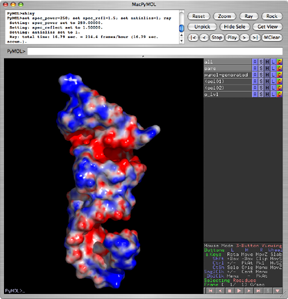This is a read-only mirror of pymolwiki.org
Difference between revisions of "APBS"
| Line 5: | Line 5: | ||
PyMol currently supports the '''APBS plugin''' written by Michael Lerner. This plugin makes it possible to run APBS from within PyMOL, and then display the results as a color-coded electrostatic surface in the molecular display window (as with the image to the right). See [http://www-personal.umich.edu/~mlerner/PyMOL/ Michael Lerner's Page] for more details, including instructions on how to download, install and use the plugin. | PyMol currently supports the '''APBS plugin''' written by Michael Lerner. This plugin makes it possible to run APBS from within PyMOL, and then display the results as a color-coded electrostatic surface in the molecular display window (as with the image to the right). See [http://www-personal.umich.edu/~mlerner/PyMOL/ Michael Lerner's Page] for more details, including instructions on how to download, install and use the plugin. | ||
| − | '''Nucleic acids may prove problematic for the apbs plugin.''' If so, use the [http://pdb2pqr.sourceforge.net/ pdb2pqr] command-line tool to create a pqr file manually, instead of using the plugin to generate it. Then direct the APBS GUI on the | + | '''Nucleic acids may prove problematic for the apbs plugin.''' If so, use the [http://pdb2pqr.sourceforge.net/ pdb2pqr] command-line tool to create a pqr file manually, instead of using the plugin to generate it. Then direct the APBS GUI on the [http://www-personal.umich.edu/~mlerner/PyMOL/images/main.png main menu] to read the pqr file you '''externally generated.''' |
==Required Dependencies== | ==Required Dependencies== | ||
Revision as of 04:47, 18 February 2006
Introduction
APBS, the Adaptive Poisson-Boltzmann Solver, is a freely available macromolecular electrostatics calculation program released under the GPL. It is a cost-effective but uncompromised alternative to GRASP, and it can be used within pymol. Pymol can display the results of the calculations as an electrostatic potential molecular surface.
PyMol currently supports the APBS plugin written by Michael Lerner. This plugin makes it possible to run APBS from within PyMOL, and then display the results as a color-coded electrostatic surface in the molecular display window (as with the image to the right). See Michael Lerner's Page for more details, including instructions on how to download, install and use the plugin.
Nucleic acids may prove problematic for the apbs plugin. If so, use the pdb2pqr command-line tool to create a pqr file manually, instead of using the plugin to generate it. Then direct the APBS GUI on the main menu to read the pqr file you externally generated.
Required Dependencies
APBS and its dependencies like pdb2pqr and maloc are freely available under the GPL. The author of the software however asks that users register with him to aid him in obtaining grant funding.
Installing the Dependencies on OS X
- First, register your use of the software. This will keep everyone happy.
- Second, if you don't already have the fink package management system, now is a good time to get it. Here is a quick-start set of instructions for getting X-windows, compilers, and fink all installed.
- Once you are up and going, activate the unstable branch in fink, and then issue the commands
fink self-update fink install apbs
or if you want to use the multi-processor version, issue
fink self-update fink install apbs
Then install the X-windows based version of pymol using the command
fink install pymol-py24
Note that the fink version of pymol already has the latest version of the APBS plugin. You are set to go!
Further details, as well as screen shots, are given elsewhere in this wiki.
Installing the Dependencies on Linux
RPMs
A variety of RPMs are available from the APBS downloads website. Again, please register your use of the software if you have not yet done so.
Debian packages
For ubuntu and other debian linux distributions, probably the simplest thing is to download a promising looking rpm, convert it with the program alien, and then install the newly generated debian package with the command
sudo dpkg -i apbs*.deb
